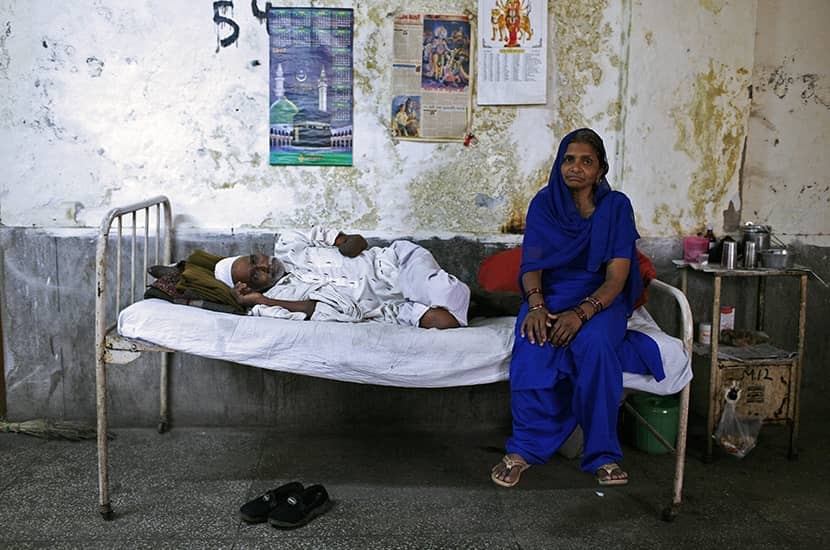If you were a teenager before 2005, one reminder of tuberculosis in British life is that small circular scar on your bicep. Maybe you’ve explained to your children why it’s there, if you ever knew. The BCG is no longer a routine vaccination in the UK, a revision which signalled to many that TB was over. What used to be known as consumption became treatable, preventable and ostensibly consigned to medical history as a threat of the past.
We tell stories about diseases as if they are constant things. ‘It’s no worse than flu’ has become a familiar phrase; but flu is not all that common, it varies wildly in severity and changes strain every year. Pathogens evolve and mutate, avoiding the risk of staying the same for too long. Despite public familiarity with Covid variants, the idea that the virus is acquiring several new identities – perhaps more infectious or lethal than what’s come before – is unnerving. That an antique bacterial scourge such as TB is also shapeshifting to subvert our biochemical and immunological defences is unthinkable. But true.

Infectious diseases do not replace or make way for each other; they overlap. Lungs hollowed out by TB are a perfect den for coronavirus. Bodies with Aids often die from TB, as HIV patients’ immune systems are weakened beyond resistance. This microbial economy stands in contrast to our divided social and emotional resources. A prominent infectious disease diverts media attention, healthcare budgets and sympathy away from others. Covid has been dominating headlines, but TB has been making quiet inroads for years. Now almost a third of the world’s population is infected. Once transmitted, the bacteria can nestle for decades in a healthy immune system before starting to replicate. In 2020, one and a half million people died from TB.
Vidya Krishnan, a health journalist based in Goa, has been working on India’s TB crisis for seven years – long before Covid – a catastrophe which could have taught us much in preparation. Both are airborne respiratory infections which favour crowded, unventilated indoor spaces. Yet Krishnan’s contention is that the similarities or differences between pathogens distract us from the more important continuities of human error that enable these diseases to flourish. ‘Plagues are fuelled by a deliberate architecture of unfairness,’ she writes.
TB has been making inroads for years, and almost a third of the world’s population is now infected
Phantom Plague challenges modern medicine’s story of progress. In many ways medicine has made TB worse. Nearly eradicated in the West, TB became highly treatable with oral antibiotics elsewhere. But these medicines are no longer reliably working. Drug resistance (DR) has been the predictable outcome of undertreating, overtreating, ignoring and facilitating local spread. The situation is now so severe that DR TB has become MDR TB (multidrug-resistant), and XDR (extensively drug-resistant). Each bacterial evolution leads to a heightened level of urgency for which scientists struggle to find adjectives: ‘super XDR TB’ and ‘totally drug-resistant TB’ (TDR TB) are the latest iterations.
India’s private physicians, who outrank public doctors by 13 to 1, have a financial interest in retaining their patients rather than successfully treating or referring them to a specialist. Studies have shown that only a minority of doctors in India know how to successfully diagnose TB – despite obvious symptoms of coughing blood, fever and weight loss – and even fewer can correctly prescribe an effective drug regimen to treat it. Individual incompetence is exacerbated by restrictive patents, fiercely protected by Big Pharma, which prevent the two effective chemotherapeutics against drug-resistant TB – Delamanid and Bedaquiline – from reaching patients in India. Krishnan includes moving stories of young women riddled with TB who are maintained on ineffective drug cocktails that leave them nauseated, suicidally depressed and deaf. Meanwhile the government’s denial of true patient numbers has shrouded this epidemic.
In the compelling chapters which describe TB’s explosion in Mumbai with its population of 20 million, Krishnan’s prose is incandescent with rage. She shows us the claustrophobic, vertical slums and luxury gated communities of ‘medical apartheid’ where money, for now, can buy some protection. However, a third of the book is dedicated to a history of germ theory and scientific method, including the contributions of Pasteur, Koch and Lister, which lacks spark. Phantom Plague would have been even more powerful if Krishnan had been convinced that her non-western story could hold its own without relying on a shallow canonical history.
What will it take for the horror of antibiotic resistance to be recognised on a global scale? Maybe when white people are imperilled to the extent that black and brown people continue to be. But whether we’re ready or not, Krishnan is unequivocal that an antibiotic apocalypse is coming. The colonial wave which brought TB from the West to India is about to reverse. And the conditions which have catalysed India’s suffering – a depleted national healthcare system boosting private practice, a precarious housing situation with growing numbers living in poverty, Big Pharma dictating the rules of engagement in a free market, government that fudges data and misleads the public, and a racist, class-divided society – sound ominously like Brexit Britain.






Comments